My virtual art show
Bringing NYC to you!
Last week I opened my art show with a jubilant soirée at the soulful exhibition space Neighbhor! I was very excited, and also very afraid no one would come!!
I spent no fewer than 14 hours figuring out how to hang all my dang woolen art from the ceiling, and many more hours googling “How do you print those gallery label thingies?” and “How many beverages do you need for an event between 5 and 100 people?”
Because I had no idea what to expect.
Witnessing so many people come through this small but mighty art space was a mystical experience, and I was so happy to meet such exquisite beings from across the city and across the WORLD (shout out to South Africa, Finland, and India!) who all share a special affection for the oddball majesty that is NYC.
Here was the scene:
With my beloved friends who came from Baltimore:
And with Ananya, a dear Blueberry who I’ve only gotten to know through newsletter comments!!! She was a real-life sparkle:
A few people noted that the show was a “success,” but I always want to investigate that word, because if 2 people had showed up—and if they were my husband and my mom—it would still be a success. It was all just bonus, amplified grace.
It was a gift to have a show, a gift to make art, and a gift to have no attachment to the art (which wasn’t always the case!). And having people come and actually engage with stuff I made was like a jar of maraschino cherries dumped on top of a cookie dough sundae.
After everyone left, I sat on the floor with Thai food and marveled at these responses:
So now, I offer you a virtual cup of LaCroix or a stronger bubbly, and I invite you into my own personal NYC by way of felt and wool.
I began this project in late November when I was searching for a time-consuming hobby that would get me through the holidays—my most dread season of the year.
Not only did I get through the holidays but I discovered an art form that helped me reconnect to my home and my purpose for being in New York.
And, I met plenty of people who are propelled by their own purpose!
But none of my art is unique to the experience of living in New York; it’s an exercise in presence to wherever one lives, or finds themself for a moment in time.
I very much hope you can apply some of these meditations to your daily life, wherever you live. Good luck finding a good bagel though ;)
SACRED CITY:
Meditations on Daily Life in NYC
Before I moved to New York, the city was my refuge. While most other DC-dwellers escaped to bucolic Shenandoah Valley when they needed a rest, I took the first Amtrak up to NYC to get my soul battery charged up.
The frequency of these streets matched up with mine so I didn’t have to strain nor calm down in order to fit in; I could just be. Manhattan was my pillow, a constant place to land. I’d return home rejuvenated as those who spent a weekend in the mountains.
Now that my home is here in NYC, I look for refuge elsewhere. The chaos gets me down, or worse, numbs me out. I find myself tuning out the noise and crowds in order to keep some semblance of inner peace as I elbow my way through subway stations and long lines. If only all these other people didn’t exist! A girl can dream…
But then I think back to how restful the city once was for me. Surely I can channel that again, some how?
My inspiration came in the form of a podcast (what else) about the purpose of the Sabbath, the sacred day of rest. Rather than tune the world out, so the hosts explained, Sabbath is about tuning in. And by becoming more present, even to chaotic surroundings, we find rest and inner peace.
I began wondering how New York would feel if I treated quotidian moments like mini-Sabbaths, fully engaged so that I could claim that rest for myself no matter my surroundings. I thought about moments that all New Yorkers will recognize: Sunday mornings with a bagel, sitting on the subway, encountering pigeons and rats.
In these mundane (but specifically New-Yorky) scenes, can we find our own City of Rest in the midst of frenzy? This is what I’ve attempted to do by sanctifying ordinary moments through attention, attunement, and meditation.
I hope you will join me in finding holy joy within New York, and allowing it to give us seconds of Sabbath throughout our days.
For these pieces I used a technique called ‘felted wool painting.’ It is a laborious process, and each one takes upwards of 20 hours to complete. I source my wool from a small family farm in North Dakota which is committed to providing their beloved sheep with a natural and joyful life.
UNDERGROUND CATHEDRAL:
Riding the Subway
Inspiration:
One of the most holy places in this city is the subway. In other cities where I’ve lived, most middle- to upper-class people own cars; public transportation is reserved for the lower classes and environmentalists. But in New York, everyone from private school kindergarteners to octogenarian fortune tellers is jammed in there together and forced to interact on some level, so you’re obligated to see a bit of someone’s humanity, not so different from yours. There’s a silent agreement that none of us are here to make new friends, but we do smile. We help. We see people with canes and give up our seats. For a few minutes to an hour, we are a very small community sharing space in a moving room, twisting underneath the city.
Meditation:
Look at someone on your commute today. If you were in love with them, what would you love about them? T’he freckle on the tip of their nose, the way their shirt is only partially tucked in, how they smile when they’ve dominated another level of Candy Crush? When you’re in love with someone, their flaws are endearing and special.
CONFESSION:
Conversation in a Taxi Cab
Inspiration:
When I’m in the privileged position to look down at the streets of Manhattan from above, I see cabs speeding, swerving, or stopped in traffic, and imagine them as vessels of secrets, transporting our confessions all around the city (and then back to New Jersey). Cab drivers know where we’ve been and where we’re going, more intimately than most.
They’ve seen us at our lowest (any time after 2am, and then to work the next morning) and our highest (wedding days, beach days, Labor Days, and all other “days” that permit us to splurge on transport).
Drivers hear our most intimate conversations, arguments, and phone calls with our doctors. They’ve witnessed first kisses, last goodbyes, and all kinds of interactions in-between. They’ve made conversation with us while our speech is slurred and when our walls our down. We’ve told them secrets we haven’t told our best friends. Where are those secrets now?
Meditation:
You may have noticed that a lot of cabbies in NYC are continually talking on the phone via a Bluetooth earpiece, sometimes so casually and sporadically—as though the person on the other line had been sitting in the passenger seat for hours—that you don’t even realize they’re on the phone until you lean forward to ask, “Excuse me?” And realize they’re not speaking to you.
Cabbies get the best business between 2AM and 2PM, a tough time to stay awake, when most of them have families and all of them have real lives that don’t fit neatly into their odd schedule. So, drivers often talk on the phone with a friend to stay awake, or just stay sane. After all, "No one ever talks to me," one of them said. "They just tell me where to go.”
Few riders are up for a casual chat. The majority will look at their phones the whole ride, while a minority will be “complete fucking assholes” according to a Guinea-born driver of nine years. Speaking to his fiancée during his rides keeps him in the right state of mind.
So, if you’re up for a talk next time you’re headed to the train station, get acquainted with a cabbie. Chances are, they know much more about the city than you do, and have stories that will entertain you for days. Ask about their background, their opinion, their loved ones.
If you’re lucky, like me, one of them will show you their pet bunny named Brownie. If you’re luckier, one might teach you a couple words in Bambara. And if you’re luckiest, you’ll leave the car with a pep in your step and a smile on your face.
Or, you could just tell them where to go.
SABBATH DINNER:
The Restaurant
Inspiration:
Candles lit, phones put away, lace-trimmed tablecloth laid out: This is Sabbath Dinner in Manhattan.
Waitstaff arrives two hours early to memorize the specials and roll the silverware, while cooks have been prepping all day. The ones who want a break from chopping are elbow-deep in deliveries, slicing open boxes and stacking heads of broccoli with factory-machine efficiency. Back-of-house handles the science of the restaurant; front-of-house handles the art. The hosts, dressed the part, slowly walk through the tables adjusting the bud vases and salad plates.
At 5pm, the ceremony begins. Friends, lovers, colleagues, and Tinder dates will come through for the next several hours, making meaning of this space that was a shoe store two decades ago and, before that, a Hungarian cafe, and, before that, a bank.
This restaurant is a meeting place for some; for others, it’s a very dear spot—the background of a long and beautiful love story. The older couple in the back knows that someday it will be replaced by a City Target, as things tend to go around here, so for now they are savoring their sacred tradition: candlelit Friday night.
Meditation:
I’ll borrow words from Anthony Bourdain for this one: “Eat at a local restaurant tonight. Get the cream sauce. Have a cold pint at 4 o’clock in a mostly empty bar. Go somewhere you’ve never been. Listen to someone you think may have nothing in common with you. Order the steak rare. Eat an oyster. Have a Negroni. Have two. Be open to a world where you may not understand or agree with the person next to you, but have a drink with them anyways. Eat slowly. Tip your server.”
SAINTS OF THE SIDEWALK:
Pigeons
Inspiration:
Pigeons are a tragic tale: They were domesticated by humans thousands of years ago. We took them into our homes—the wealthiest homes, at that—in Europe, Asia, and North Africa. Then…we sort of forgot why we did it in the first place. We used to use pigeons to carry messages (really, they have always been phenomenal navigators), or at least use their poop for excellent fertilizer. We bred them specifically so they would hang around us.
Now we get annoyed that they still do. They are the fax machines, the heavy black-and-white TVs, the CD-ROM drives of animals. Once essential, they now take up space in our homes. If they would just leave our parks and moldings, we could modernize in peace. The problem is, pigeons were bred to be good at living near us. And then we forgot about that, and we’re wondering why they’re hanging around.
As someone who feels more comfortable on the edges than in the center, my heart goes out to this man and his bird community, who have both been pushed farther and farther from the center to the point where many of us might literally not even see them. While the richest of the rich used to keep pigeons in cages as a sign of wealth (they were rare, and exclusive), now we associate this colorful dove with the poor.
In Mary Poppins, it’s a weird old woman who chooses to feed the birds, tuppence a bag. All the businessmen scurry past her to avoid being asked for spare change; it’s only the children who stop and feel moved to buy seed to give these city pests.
In various parks around New York City, it’s someone who the rest of us may think of as ‘not mentally there’ enough to hold a job. It’s no surprise that they find companionship with an intelligent, compassionate, physically beautiful species who has been cast aside as useless and a pest.
Meditation:
Reflect on what you consider “useful” or not; then think about how you treat either. What in nature is useful, or not? Which animals are useful, or not? Which people are useful, or not? If we look at radical prophets like Jesus, they were constantly questioning our perspective on what mattered and what didn’t. What if, today, the once-useful pigeon actually mattered? How would you treat it?
THE ART OF CONTEMPLATION:
A Wandering Weekend
Inspiration:
My favorite activity in New York has always been wandering around. Aimlessness lends itself to serendipity, which has a particular flavor in NYC—“the New York magic,” as my friend calls it.
It’s not the kind of magic that you’d see on a safari or while chasing the Northern Lights; in fact it’s not really magic at all…just ordinary people doing ordinary things. But the difference is that in New York you get to witness it: a first kiss, an act of kindness, an outburst of emotion. Since so much of New Yorkers’ lives are lived outdoors in public on the streets, we get to see humans up-close, in all their wonderfulness and weirdness.
If you wander with your eyes wide-open, you’re sure to find something you’ve never seen before: funny graffiti, a secret garden, or a tiny cafe wedged between the post office and fancy spa. If you wander far enough in New York, you’ll inevitably discover 1) a bookstore, 2) a shoe repair, 3) and a shop selling a highly-specific product, like rubber stamps or novelty socks.
I mark these off my mental BINGO card every time I take a Saturday to go exploring, just like I did when I first moved here, and I realize that the city has become knowable and yet remains unknowable at the same time.
Meditation:
Put your phone on airplane mode and put your watch in your pocket. Today is your Sabbath, and you’re going to spend it by flexing your senses.
See: Or should I say Look. Not for anything specific—just look around. Look around a used bookstore and peer into a tome about Mesopotamian inventions (who would discard such a book??). Look at the rumpled and penned-up pages, look at man reading the paper behind the cash register, look at the lighting and appreciate the crooked sconce, look through the dirty window and see the West Village as a smudgy watercolor painting.
Smell: Take a whiff of the streets—not with dread, but curiosity. Does New York really smell bad, or does it smell like life? What does life smell like? Hot donuts mixed with dog feces mixed with sewage and a top note of luxury leather? You don’t have to wear it as a perfume, but maybe attempt to appreciate how distinct the smell of a city is, and how different from, say, a suburban shopping mall. Inhale a few used encyclopedias at the bookshop and ride the high all day.
Touch: Touch your way through town (bring hand sanitizer if you’re grimacing). How would a blind person navigate this block—by memorizing the patterns of wrought iron and brick? Run your fingers through racks of clothing and along the spines of the bookshop’s philosophy section. Read the physical newspaper and pick up litter; grab the cash out of your tote bag and give it to the mariachi band on the subway. We avoid the fact that we are human animals in a human city by refusing to touch it. But embracing a little filth in our midst helps us embrace our internal filth, that which makes us human and humanly connected to every person in this filthy majestic metropolis.
Hear: When the siren hurts your ears, pretend it’s a wild opera singer who has gone rogue in her final performance. When honking agitates you, pretend it’s an audience clapping for your latest accomplishment. Cafe chatter is the breeze through a wildflower pasture and a garbage truck beeping is staccato notes from a violin concerto.
Taste: Vow to buy a cheap snack or drink that you’ve never had before: Spanish hot chocolate from the churro cafe, a cup of cut mangoes from the corner stand, a vegan empanada, mystery dumpling, or the latest pastry abomination (croissant meets creme brûlée).
OUR BLESSED BRETHREN:
Rats
Inspiration:
My first order of business in my new apartment was putting in several bird feeders, as this alleyway was like a strip mall for cardinals, jays, doves, and swallows that swarmed around picking at our flower buffet that I imagine resembled a courtyard of Panda Express, Sbarro’s, and Orange Julis for our feathered neighbors.
I was proud of myself for contributing an extra treat of seed to the birds’ utopian cafeteria, when I heard a nearby window slam open and saw my neighbor Bob’s Santa-Claus-beard emerge from his living room. “Hey Mari!” He called, “Sorry to say this, but bird feeders are going to attract rats!”
The word alone made me wince. “Oh gosh, eww, thank you,” I replied, as though Bob had just informed me that I accidentally hung an offensive flag outside my door. Instinctively, I took down the feeder and flung it into my storage area.
Then, I started questioning. Why, exactly, did I not want to feed the rats? If rats were dirty, bluejays were probably dirty too. Later I would learn that rats are less likely than cats or dogs to catch and transmit parasites and viruses. If rats were dangerously full of disease, most of New York would have the plague.
Is it simply that rats aren’t as pretty as birds? When animals don’t serve a purpose for us (pleasing appearance included), we tend to cross our fingers that they’ll just go away.
According to most humans, rats are perfectly acceptable to fear, despise, torture, and kill without a second thought. If you see one, it's reasonable to trap it. If you like them, something is off.
I wonder why this started. It feels rather random to me; we set out food to attract sparrows, but god forbid the rats eat it instead! The only food we deem rats worthy of is the bait that obliterates them.
My working theory is that rats are actually too human. While we’d like to believe that we are as selfless and ego-pleasing as dogs, maybe we are much more like resourceful rats, who are social to the point of having a sense of humor and a sense of regret. Is it that rats remind us of the human traits we would rather forget, and that is why we don’t like to see them?
What I think is happening with rats is....
They remind us too much of ourselves. We can't handle it.
Rats only live where humans live. They thrive in cities, among crowds and cramped spaces signaling "Here's where the people are." What we call our "garbage" is their life source: they eat what we eat, they love what we love, they seek refuge where we seek refuge.They find homes in our beloved parks, backyards, subway stations and rivers.
Rats are highly intelligent, particularly in their capacity for emotion. Besides humans, rats are the only animal who can feel regret about their actions. They have extraordinarily sensitive ears and appear to enjoy music, demonstrating strong individual preferences for certain genres.
They recognize each other and display the same symptoms of grief that we do when a family member dies. Their brains are very similar to ours in makeup, and in many cases their problem-solving abilities have far exceeded our own.
Perhaps a part of us intuitively knows that, and that's why we trap them in boxes that we can't bear to look at. It's too hard to acknowledge that this thing that repulses us is so, so very much like us.
Meditation:
Is there a part of you that you shove to the corners of your being because it’s almost too real, too difficult to see in the daylight?
MINIMART MECCA:
The NYC Bodega
Inspiration:
Years ago, I remember reading a feature on prisoners in DC in response to the question, “What view would you most like to see from your prison cell window?”
One of them said that he would most like to see the Best World Grocery Store because it was the town plaza of his neighborhood—a melting pot of so many walks of life, where he learned how to speak Spanish and speak polite English and speak his own mind. He credits the grocery store for teaching him about different cultures and about his culture. He was introduced to his favorite foods AND best friends there.
Meditation:
Instead of ordering groceries from an app where food products come zipping to your door from a mystery location (most likely a warehouse in Queens, as so many mysterious products seem to find their origin), step outside tomorrow morning and get your sparkling water, the mozzarella you forgot to buy yesterday for tonight’s recipe, and, why not, a pint of Rocky Road.
Take notice of who’s sharing the space with you. Can you learn something from them?
LOVING OUR ENEMIES:
Dealing With Tourists
Inspiration:
I leave my home, and I enter chaos.
The scene: People literally bumping into each other nonstop, clumps of teenagers crowding in front of doorways, bartenders unloading bottles in the background of wedding pictures, a delivery truck honking through a music video, and a few children screaming out in boredom and photo fatigue.
I live in a very touristy neighborhood. It's like this all the time. (Then it becomes a ghost town around 7pm.)
The neighborhood is called Dumbo, and the advent of Instagram brought a wildfire interest in this stretch of Brooklyn, particularly for this one view (depicted). I want to aggressively point to the signs around Dumbo saying "Be respectful: People actually live here!"
I know it's a ridiculous thing to get worked up about. As my friend noted, "Your biggest complaint about where you live is that your street is too photogenic."
But it's the most common collective woe about the neighborhood.
Whenever I say where I live, I hear the same response, "I love Dumbo except for all the tourists."
Except for the tourists. Too many tourists. Do the tourists get annoying? I couldn't stand all the tourists.
It's an ugly but natural defense that comes up in me often as I walk the blocks around my apartment building, essentially: I belong. You don't.
Meditation:
It's very easy to be annoyed with tourists because we can so easily "other" them. They eat at restaurants that we wouldn't be caught dead in. They stand in line for offensively mediocre pizza. They're easily swayed into overspending. They're nothing like us!!!
But...they are exactly like us.
And when we talk to tourists individually, we remember that. There's a winsome man traveling alone with his guide dog, a golden retriever who is bilingual in French and English and is "a little jet-lagged so she's grumpy." There's a couple who are eating pancakes for the first time, and can't stop grinning. There's a young woman who took the wrong express train and ended up an hour from her hotel. We've all been there. I was there a week ago.
While New Yorkers (like me) seem insistent on avoiding tourists, the alternative is sweeter: When I give up whatever impulse is compelling me to assert my belonging, I chill out and enjoy. I appreciate hearing ambient Danish. I adore watching people gasp as they finally catch a glimpse of the bridge. I happily give directions (apologies to anyone I've given directions to).
We're all both guest and host, wanderer and welcomer, and just because someone's taking a selfie on my street doesn't make them any more ridiculous than I am. (Though I hope they think I'm cool when I go into my building.)
Before performances of Hamilton, Lin-Manuel Miranda would remind the cast, "This is someone's first show, and this is someone's last show."
When I'm elbowing my way through the flocks of selfie-ers and matching- shirt tour groups, I remind myself of the same. This is someone's first trip, and this is someone's last trip. Treat them accordingly.
GRACE AND GRATITUDE:
Takeout and Delivery
Inspiration:
Many of us who live in New York enjoy an embarrassment of riches when we’re feeling peckish. I’ve found myself growing increasingly hungry as I frantically Google “BEST pad thai in New York,” never content to settle for the noodle dish down the street.
A big part of why I live here is that I get to make a lot of choices on a given day (for someone who grew up on Choose Your Own Adventure Books, this is a huge deal), but I never want to lose sight of how much abundance is available to me and how easily I can lose track of it.
Meditation:
In the time you’re waiting on your delivery, consider every single human involved in bringing your dinner to you:
1) The delivery guy who saved money for months to buy his bike, and the family who encouraged him to take the treacherous journey to America because they believed it could give him a better life,
2) The cooks sweating in the back of the fluorescent-lit kitchen of a beautiful restaurant, those who have been sautéing noodles for seven hours now and dream about sleep that’s on the other side of their 90-minute commute home,
3) The hostess who packs your delivery bag and plastic utensils, who just got a text from a guy she’s been seeing—he’s been seeing other women, and she’s devastated,
4) The immigrants who harvested the peanuts for the condiment that will be thrown away later tonight.
HOLY COMMUNION:
Bagel, Coffee, and the New York Times
Inspiration:
It would be difficult for any church in any of the five boroughs to compete with the sacred ritual that is a paper cup of coffee—too weak for the alchemic elixir that oozes out of its insufficient seams—accompanied by a bagel elaborately spread with cream cheese, no matter how often you say “Light on the schmear.” Both stain the Sunday morning paper, plump in its combo of news and nonsense for a day that is equal parts preparation and passivity.
Meditation:
Your phone ruthlessly competes for your attention during the work week, so this is your time to claim it back. Let your eyes dilly-dally from article to article, not in an attempt to consume or react but just to amble, perhaps even for (gulp) pleasure. Can the news ever be pleasurable? Yes! You might learn about a Lithuanian salsa star or ponder a low-stakes ethical dilemma or enjoy an interview with an Olympic synchronized-swimming hopeful whose journey warms your heart.
BALCONY BARDO:
Life in Liminality
Inspiration:
As a culture, we have no idea what to do with liminal space. Think: transitions, processes, “not still there, but not quite here” times of life. Extreme examples including nursing homes and hospitals—we put our “in between” citizens far away from view so we don’t have to think about them.
Perhaps those spaces are so scary because they’re uncertain, as Mystic Christian theologian Richard Rohr writes:
Liminal space is an inner state and sometimes an outer situation where we can begin to think and act in new ways. It is where we are betwixt and between, having left one room or stage of life but not yet entered the next. We usually enter liminal space when our former way of being is challenged or changed — perhaps when we lose a job or a loved one, during illness, at the birth of a child, or a major relocation. It is a graced time, but often does not feel “graced” in any way. In such space, we are not certain or in control.
We don’t have greeting cards for transitions the way we have for losses and arrivals. We don’t know how to announce on social media that we’re in limbo, the way we boldly announce a new job or even a layoff. While our beginnings are lauded and our endings are lamented, our liminality is just….there.
But every spiritual tradition sees the liminal space as magical, transformative, even holy. The Celts called it a “thin place,” which is where we are taught how to live. Tibetans call it “the Bardo,” the intermediate gap between a death and new life. Fairy tales place the sorcerer or enchanted godmother outside of town, in the woods. Traditional stories seem to intuit the alchemy that happens on the margins.
Think about it: When you’re in the center of things, you get wrapped up in what matters to the majority. You get confused between trends and your own values. You struggle to see the center for what it really is.
But on the edge, you easily see the center’s flaws. You may still be endeared enough to hang out along the margins, but you see it all differently, and more clearly.
Richard Rohr describes a prophet: “He or she is always on the edge of the inside. Not an outsider throwing rocks, not a comfortable insider who defends the status quo, but one who lives precariously with two perspectives held tightly together -- the faithful insider and the critical outsider at the same time.”
I remember this when I find myself in an awkward, uncomfortable, in- between time...when I’m waiting for the next, but can’t go back to the last. There is transformative power here. The Druids would be worshipping me. The Celts would ask me questions.
And in New York, birds would build their house on me. Yes: birds only build their nests on the “in-between” places in New York...ledges, balconies, fire escapes, windowsills. They see these spots as part-wilderness, part- protection.
Meditation:
Observe the balconies (i.e. fire escapes) of New York and see what is placed there. More often than not, you’ll see life growing on those ledges: bird families, potted plants, a neighbor sitting outside to think. We may think of these in-between spaces as just extra or even awkward—what chair is going to fit out there??—but they provide texture to NYC’s landscape and oases for animals and perfect places to add just a bit of beauty in the form of basil in terra cotta pots. What is growing in your own liminal space?


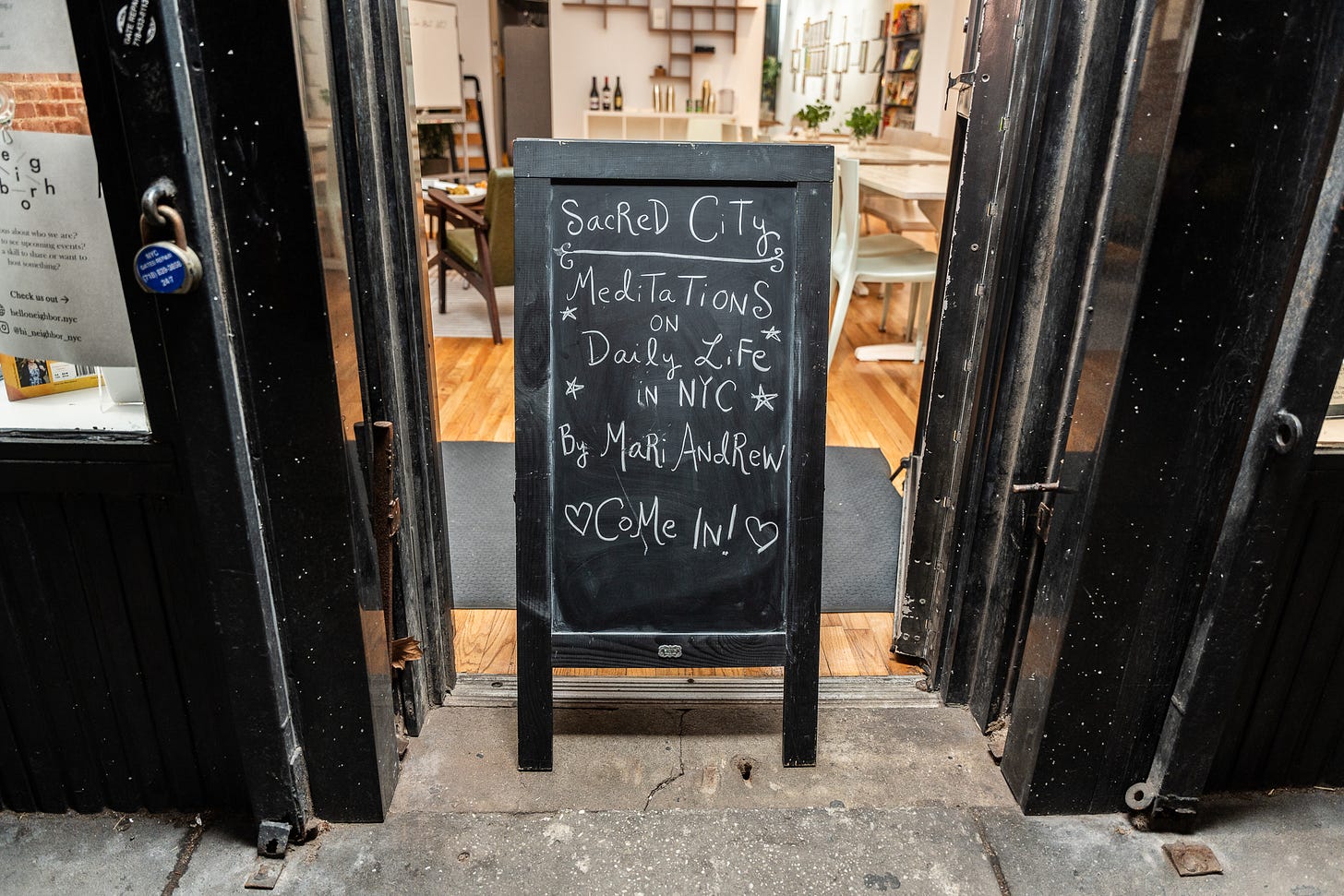



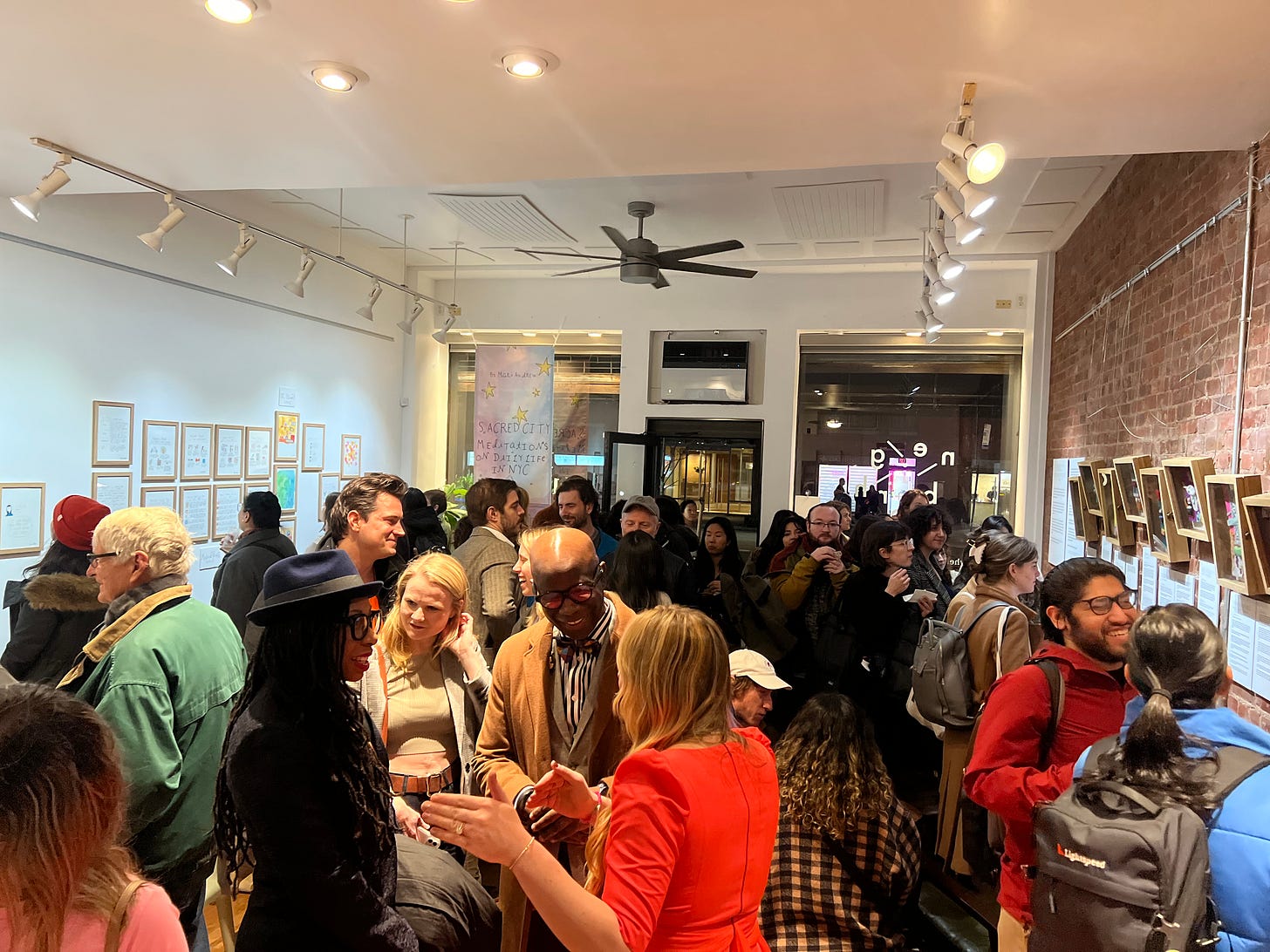
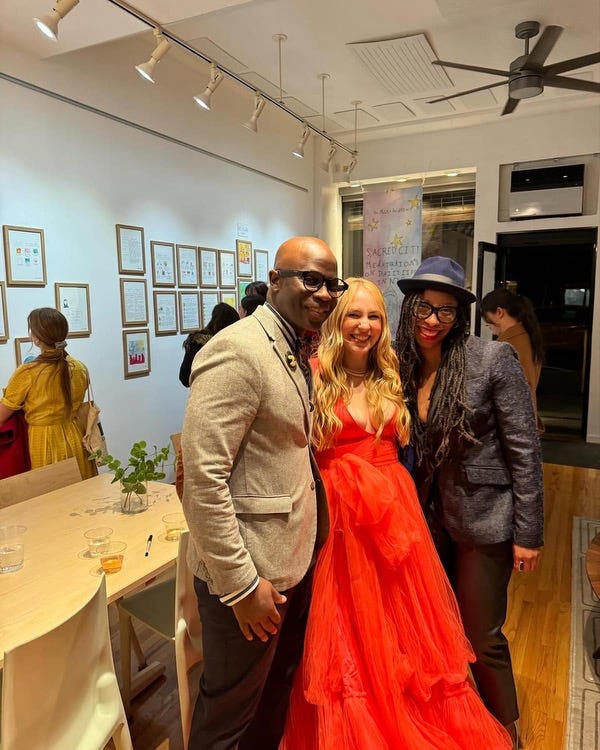



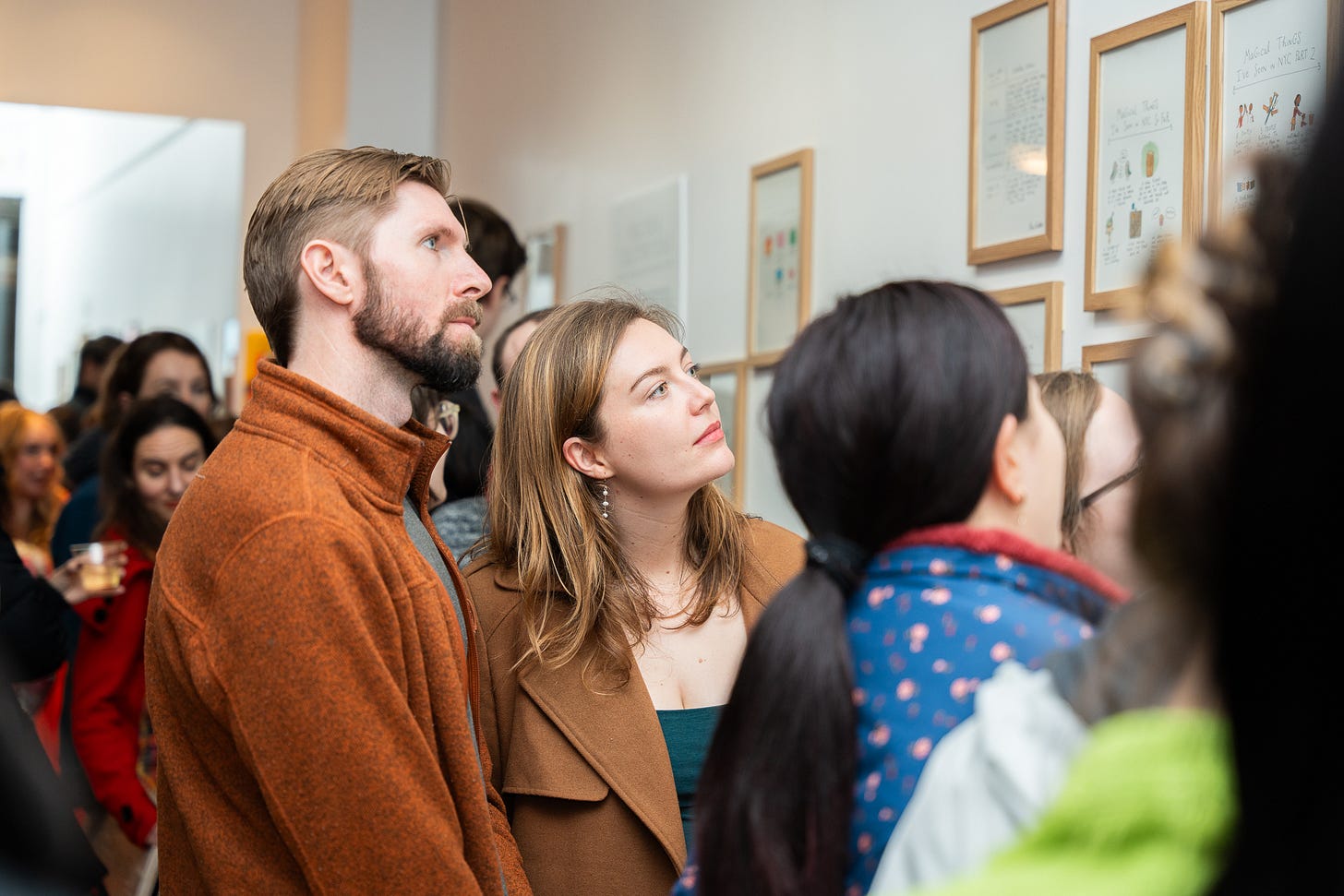

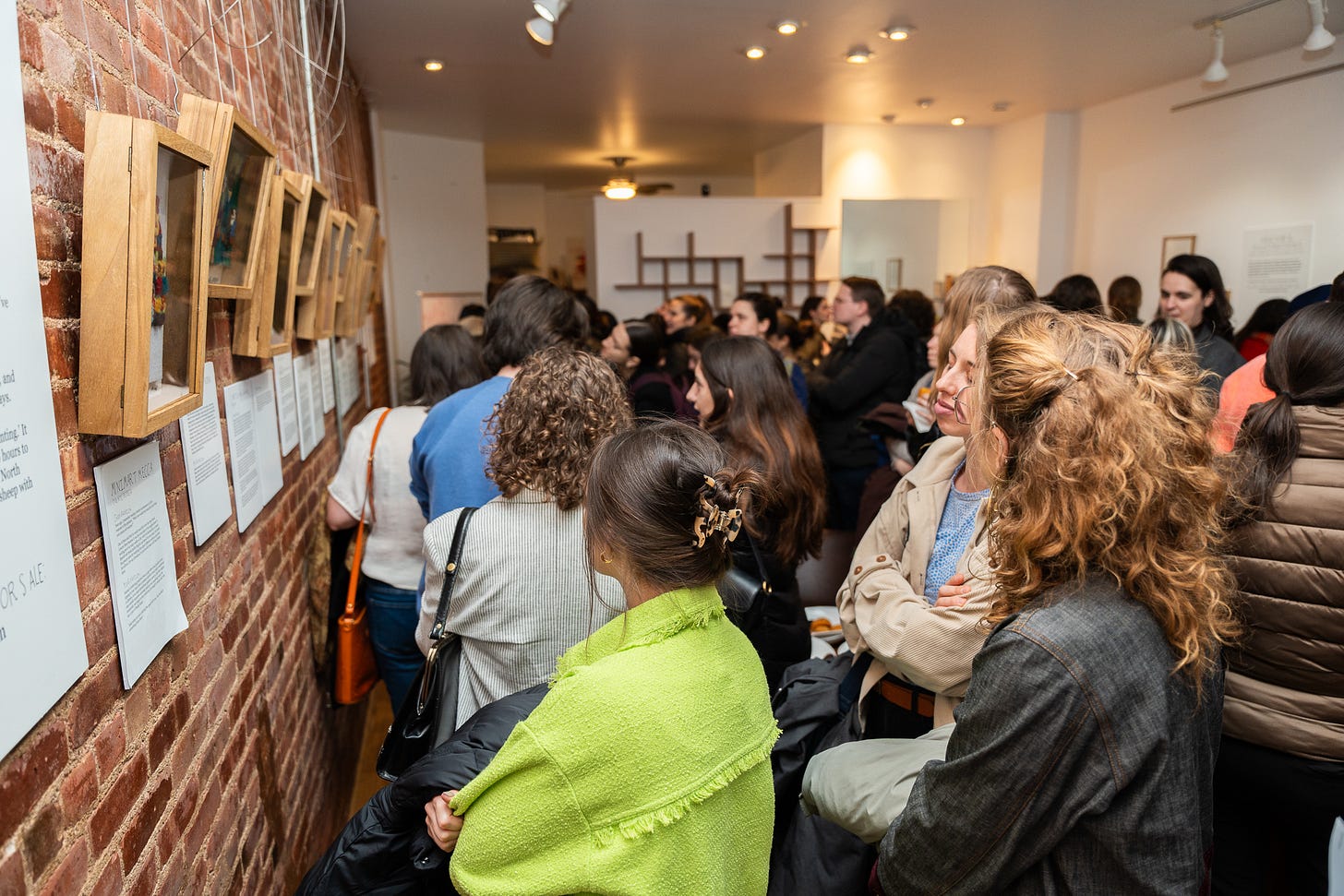



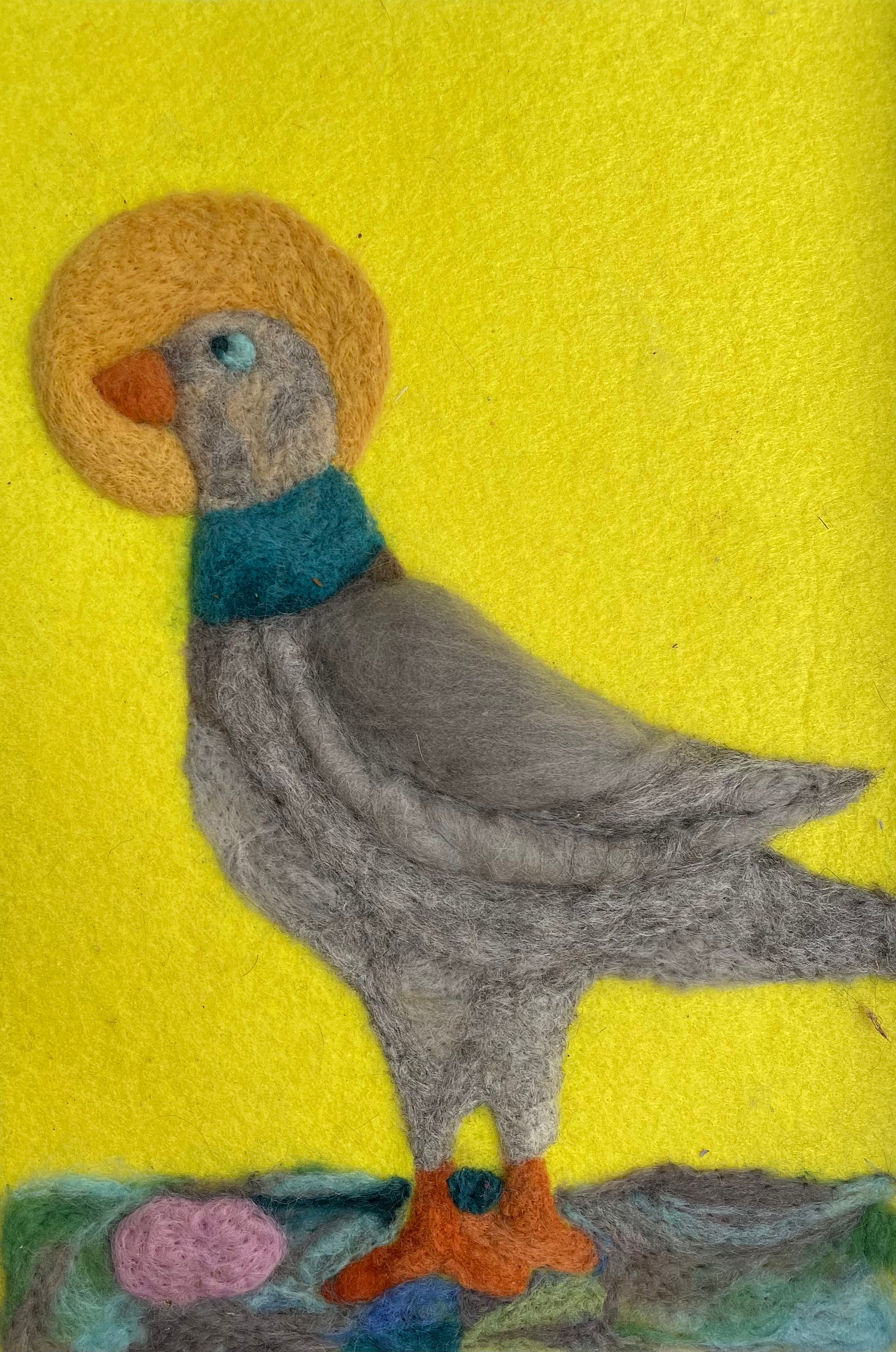
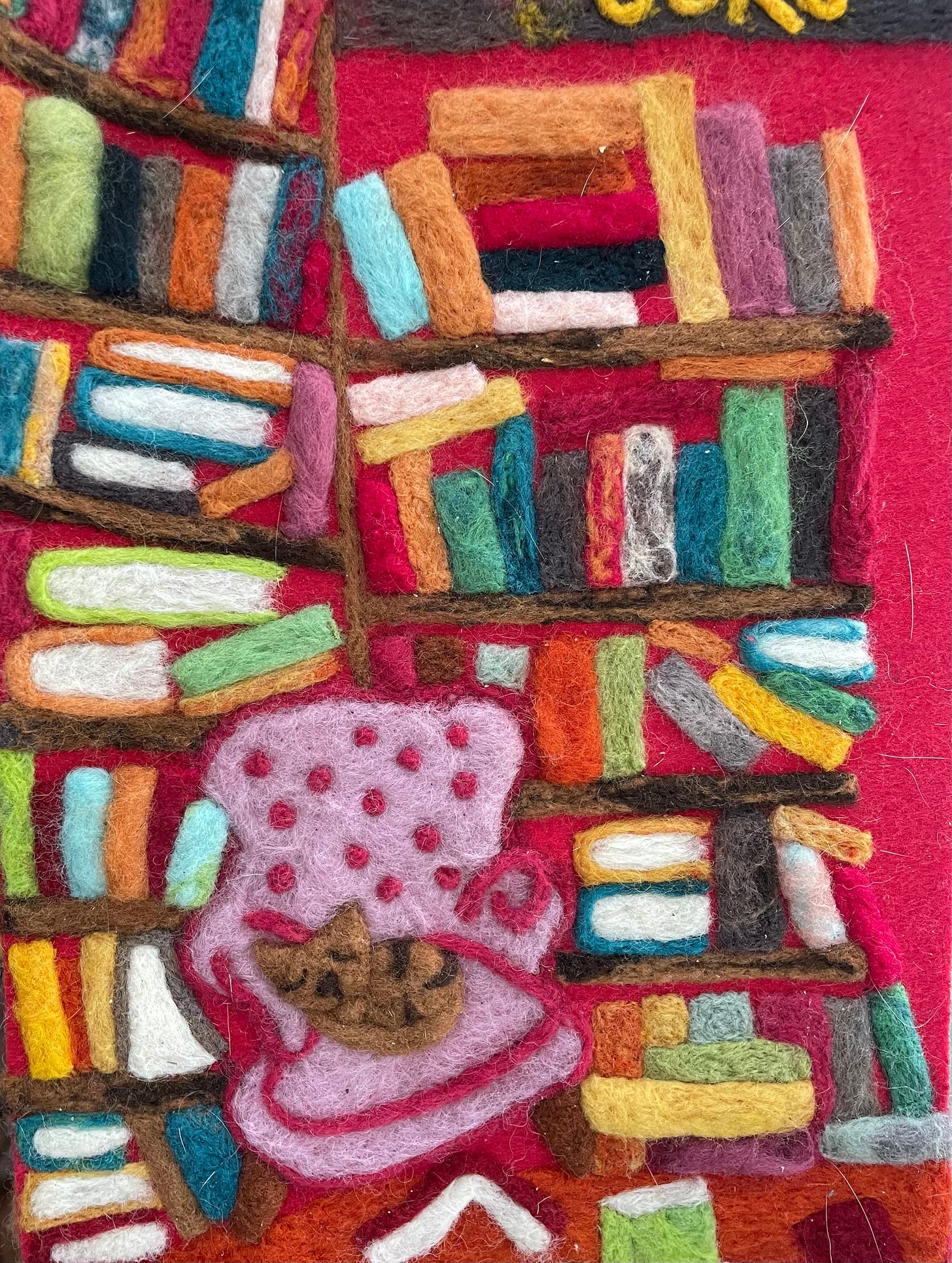

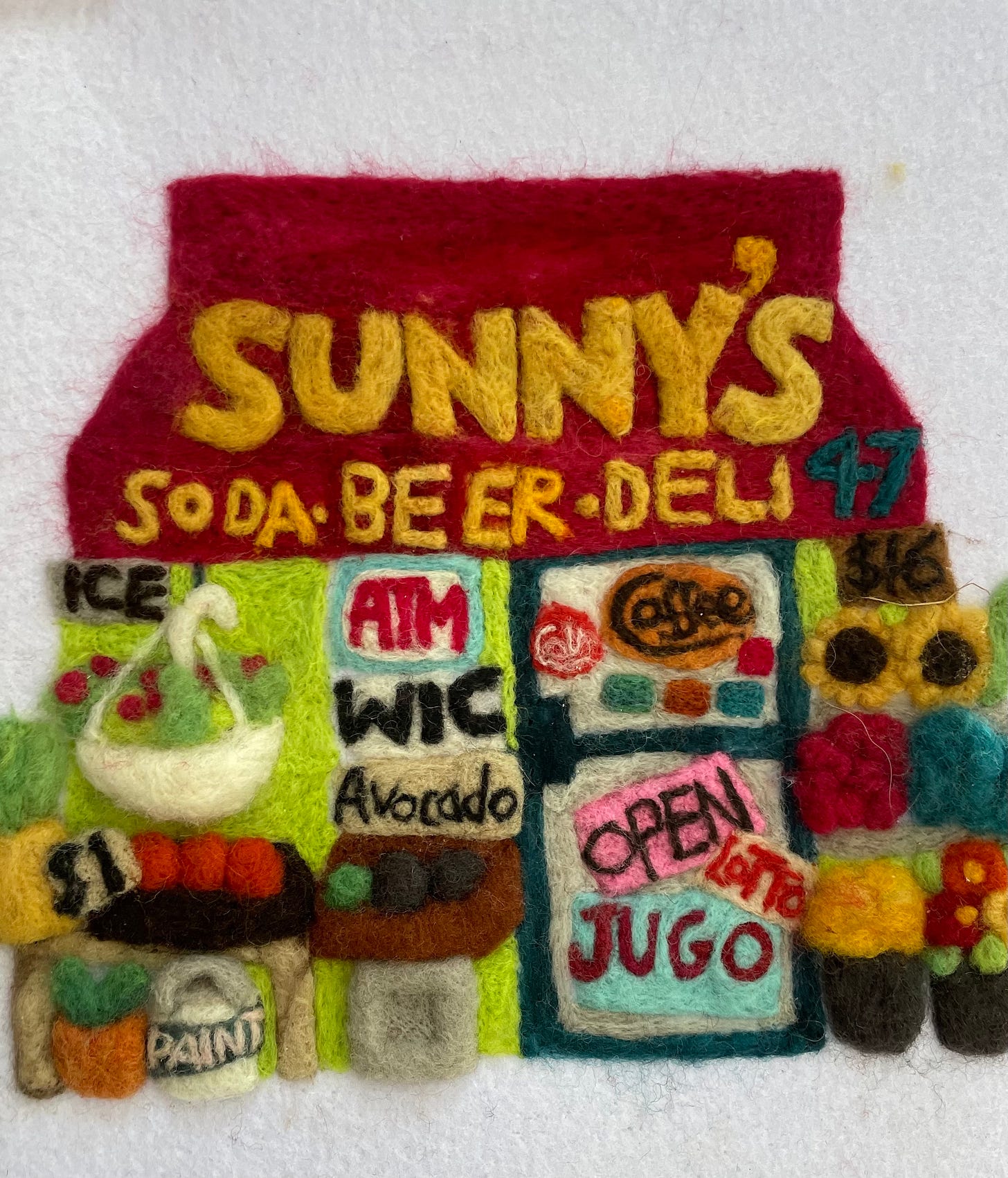

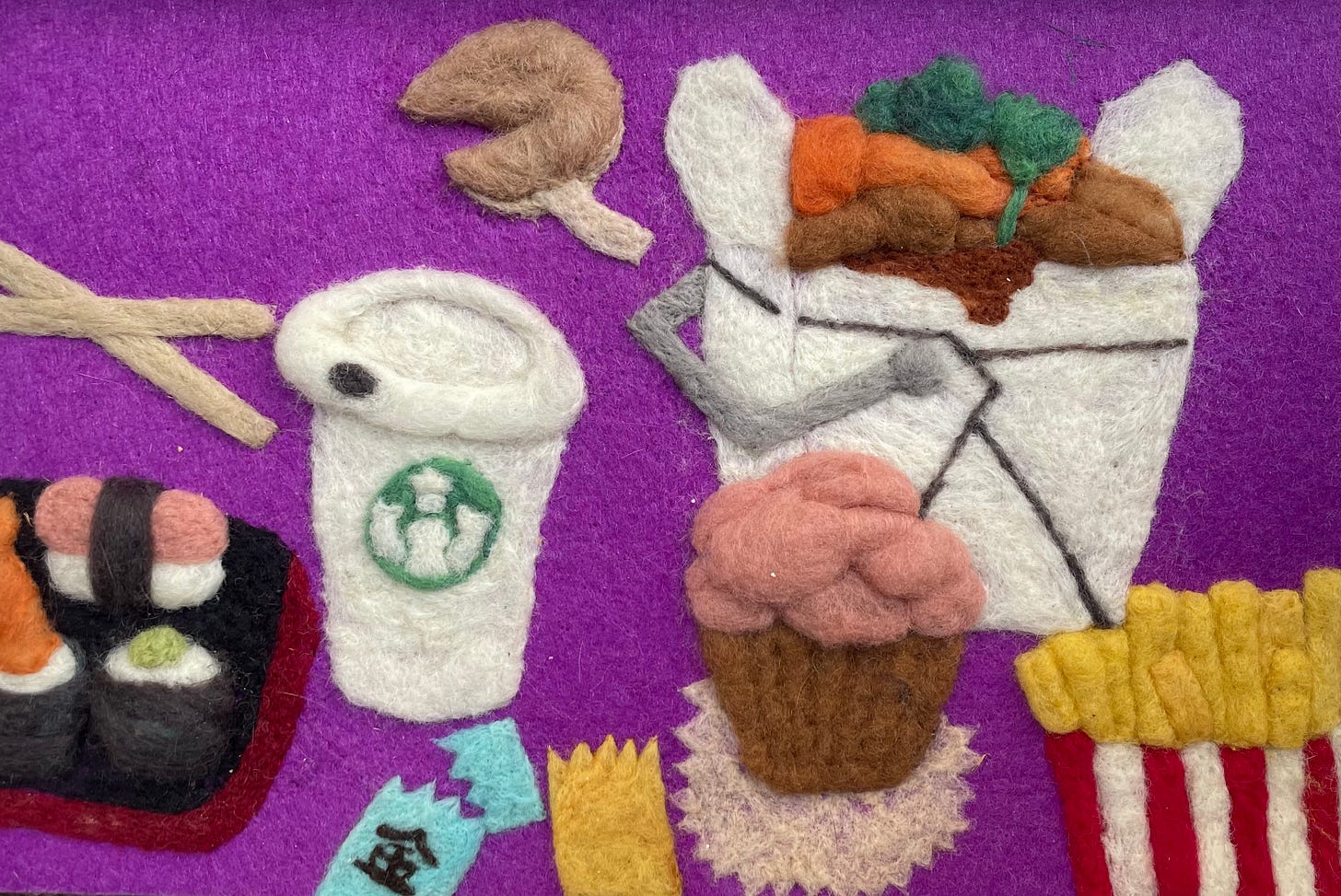


What a truly beautiful expression of love this show is! I love seeing how you so wonderfully celebrate even the rats as ‘beloved brethren’. It’s a gift to be able to visit the world through your eyes. Grateful for you, Mari!
This was a delightful surprise! The work is lovely and I wish all art placards were as thoughtful and thought provoking. Thank you for sharing!